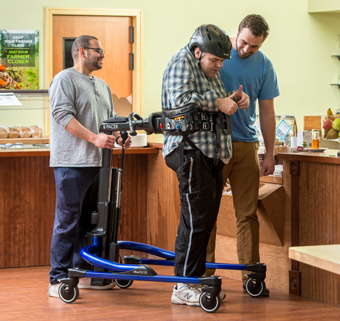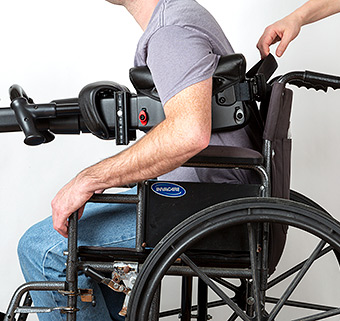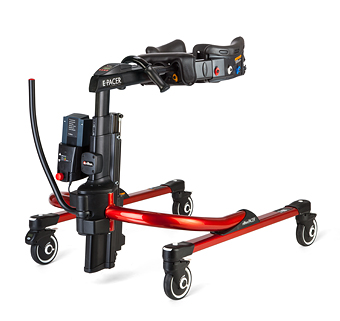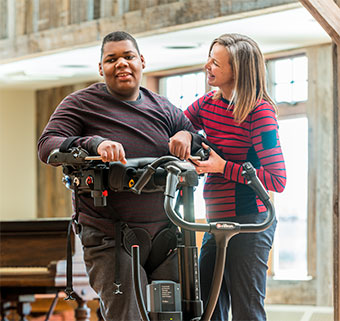Sample LMN for the Rifton TRAM: Homecare Setting for Adults
| December 2013Components of a Letter of Medical Necessity for use in the homecare of an adult.
Note: Every reasonable effort has been made to verify the accuracy of the information. However, sample letters of medical necessity are not intended to provide specific guidance on how to apply for funding for any product or service. Health care providers should make the ultimate determination as to when to use a specific product based on clinical appropriateness for a particular patient and applications to any funding source must accurately reflect the facts unique to individual applications. Third party payment is affected by numerous factors and Rifton cannot guarantee the success in obtaining insurance or third party payments of any kind.
Briefly introduce who you are, what you want, and the beneficiary.
As Jane Doe’s therapist, I am requesting funding authorization for a Rifton TRAM. This durable medical equipment device was trialed with the patient in her home on ______. Present with me during the trial and providing input were: Jane Doe, XX her spouse and primary caregiver, and XX, a certified Rehabilitation Technology Supplier with Home Medical Solutions, Inc.
Establish your credentials and relationship to beneficiary.
I am a physical therapist in private practice serving patients in both home-care and long-term care settings. I am a board certified neurological specialist with the APTA with additional experience in the geriatric setting. I am also a certified Assistive Technology Professional. I have been Jane’s home-care physical therapist for the past 8 months.
Explain beneficiary’s condition, including diagnosis or nature of the injury.
Jane is a 68-year-old retired administrative secretary who has a long-standing diagnosis of high functioning incomplete spinal cord injury at the lower lumbar levels resulting from a motor vehicle accident at age 27. Until recently she used a manual wheelchair, was placed in a stander one hour a day, and was capable of ambulating short distances in the home with a standard walker and the close supervision of her spouse/primary caregiver. However, her ongoing health issues have resulted in significantly decreased mobility in the home. These include Type II diabetes, congestive heart failure under medical management, and borderline obesity. Because of past issues with constipation, Jane is currently on a bowel management program.
Describe beneficiary’s current functional level noting their limitations without the requested equipment.
Jane presents with significant limitations in her gross motor and functional mobility skills from the spasticity, lower extremity muscular weakness and impaired motor control secondary to her diagnoses. This affects her balance as well. Jane requires moderate assistance from her spouse/caregiver to transfer from supine to sitting. Once she is sitting at the edge of her bed, she maintains this position with close supervision/contact guard one minute. However, for her stand and pivot transfers from bed to wheelchair and from wheelchair to commode or shower chair she requires maximal external support. Jane bears approximately 50% or less of her weight during these transfers and is at high risk for falls. Recently, with her age and declining health, these max assist manual transfers have become increasingly difficult and unsafe for Jane and her spouse/caregiver.
Currently, Jane cannot stand or walk without maximal assistance of two adults. Because of this she is no longer able to transfer in and out of her stander as her spouse/caregiver is often the only one at home.
Jane’s increasing dependence on transfers impacts her hygiene care. As she is now unable to transfer safely to the commode, she needs regular diaper changes on the horizontal surface of her bed, impacting her dignity and quality of life. These increased episodes of incontinence place her at increased risk of skin breakdown and add the expense of disposable hygiene products.
With continued dependence on her wheelchair, Jane is progressively losing what little functional abilities she had. Prolonged sitting also puts her at an increased risk for pressure ulcers, contractures, and osteoporosis. Without the requested equipment, she does not have the capacity to effectively participate in transfers and improve her transition skills. Although she can bear up to 50% of her own weight, she has no support for continued weight-bearing or any ambulation skills. It has been shown that even the most significantly involved person, given enough repetitions, can improve skills, but there must be many opportunities to practice them. Without the appropriate support and equipment, Jane will regress, becoming fully dependent for all transfers and functional mobility. As she is already at risk for increased obesity, the prospect of inactivity and subsequent physical dependency is of significant concern. Transfers will become more demanding for her caregiver, placing him at risk of severe injury. If her spouse/caregiver is unable to provide appropriate care in the home, it will be costly to place Jane in a facility to receive the care she needs.
Discuss the needs and safety factors for care providers of adults with significant support needs.
Jane is dependent for all transfers and is becoming too heavy for a single caregiver to transfer safely. Current literature suggests that no caregiver should lift more than 35lb of a patient’s weight, under ideal conditions. [Waters TR (2007). When is it safe to manually lift a patient? American Journal of Nursing 107(8):53-58.] Jane’s spouse is routinely lifting more than this guideline weight.
As Jane is unpredictable with her weight-bearing, her transfers need to be performed safely and effectively. The two manual transfers observed in today’s session were stated by her spouse to be the typical daily transfers for Jane: (1) a dead-lift pivot transfer as a full one-person lift and (2) a stand-pivot transfer with Jane holding onto a grab bar, also requiring maximum assistance. Her weight, muscle tone, and lower extremity weakness make it increasingly risky for her spouse to continue doing the manual transfers that the assessment team witnessed in the patient’s home today.
At this point it is recommended that Jane’s caregiver use an appropriate transfer aid to address the needs and safety issues that are present in the above situation.
State the type of equipment and accessories being requested.
I am requesting a Rifton TRAM for Jane with forearm supports, additional thigh straps, pelvic support, built-in scale, directional lock and charger power cord.
The Rifton TRAM is designed to perform the functions of three pieces of equipment in one unit: a lift system, a stander and a gait trainer. Specifying one product that fulfills three functions will mean the purchase of one product rather than three separate products, which is a significant cost-savings. Furthermore, having one device reduces the storage space required in the home.The Rifton TRAM supports even the most significantly involved individual in seated transfers, sit-to-stand transfers and gait training, enabling lower extremity movement that is comfortable, safe and therapeutic. Being upright also improves the patient’s respiration, digestion, circulation, bowel/bladder function, and provides the opportunity for gravity-assisted stretching, self-initiated joint ROM, and improved bone density. Further, the TRAM’s unique body support system eliminates any lifting by the caregiver, reducing chance of caregiver back strain or injury.
Describe why the device is medically necessary.
Because of Jane’s diagnoses, she is dependent on her spouse/caregiver for her self-care and mobility. The Rifton TRAM is medically necessary for Jane because it will give her the much needed support in all her transfers for activities of daily living, plus providing opportunities to participate in the transfers and to practice standing and gait. These are important functional skills for Jane to work on and maintain so that her spouse can continue to provide Jane’s care in their home.
1. Seated Transfer. The Rifton TRAM’s ultra-light, compact and versatile design will allow its use in confined spaces such as the patient’s bedroom and living room, for transfers from bed to wheelchair and to shower/commode chair. During the trial with the TRAM, Jane’s spouse was able to effortlessly maneuver the TRAM with Jane Doe through all necessary positions in the home environment.
Particularly important is the transfer from the power wheelchair to a rolling shower/commode chair. This gives Jane regular and routine opportunities to toilet and shower effectively. Transferring with the TRAM is quick and easy, decreasing the chance of toileting accidents and subsequent skin break-down. The Rifton TRAM’s unique transfer options also enable one caregiver to assist Jane to the bathroom. Jane needs this solution to hygiene and toileting care that aligns with her dignity and emotional needs.
Selecting the TRAM for toileting will eliminate the need to obtain a separate additional lift device for toilet transfers (cost estimates in the range of $3000 - $7000).
2. Sit-To-Stand and Supported Standing. Jane had been participating in a daily standing program that allowed her to stand erect with support and bear weight through her lower extremities. This was discontinued secondary to transfer issues and concerns.
However, the opportunity for being positioned in standing still remains important to Jane’s overall health. With the use of the Rifton TRAM, this continued weight bearing is made possible. The Rifton TRAM is medically necessary to support Jane in standing to maintain her joint, muscle, bone, and skin health. Relief of pressure on skin surfaces with this change in position will decrease the risk of skin breakdown due to prolonged sitting. Being upright at intervals throughout the day will provide the opportunity for gravity-assisted stretching, self-initiated joint ROM and stimulating bone mineral density to help counter the process of osteoporosis. The upright position also improves respiration, digestion, circulation, and bowel/bladder function, all of which are beneficial to Jane’s health.
Jane’s spouse is able to transition Jane from sitting to standing using the TRAM pelvic support with ease and safety. Jane’s spouse expressed his strong opinion regarding the beneficial value of frequent opportunities for Jane to stand, as this places Jane at conversational height and would contribute toward her psychological and social well-being, promoting continued mental-emotional recovery.
The supported sit-to-stand function of the Rifton TRAM will allow Jane to safely participate in transfers, bearing as much weight as she can tolerate. This will at least maintain her current level of functional mobility or even build on it.
Selecting the TRAM for standing will eliminate the need to obtain a separate additional adaptive product for supported standing (cost estimates in the range of $3000 - $6000).
3. Gait Training. During the trial with the TRAM today, Jane was able to take numerous steps forward with her spouse/caregiver occasionally assisting her right leg. There was no fall risk while Jane was supported in the TRAM. Her physician and the members of the assessment team agree that Jane has the potential to improve her motor functions with the right durable medical equipment, making the TRAM a medical necessity. Ambulation, such as occurred today during the trial with the Rifton TRAM, has numerous essential health benefits.
- Bone is deposited and formed in response to stress on the bone tissue according to Wolf’s law. Ambulation distributes Jane’s body weight more evenly onto each leg during the single leg stance segment of the gait cycle. This will have a positive impact on bone mineral density, since Jane is at risk for increased osteoporosis with lack of physical activity.
- The inability to ambulate also increases her risk of joint contracture. Muscles that are immobilized and remain in a shortened position are at a high risk of becoming contracted. Increased opportunity and practice transitioning from sitting to standing and walking will strengthen her muscles and maintain her range of motion.
- The opportunity to ambulate provides Jane with physical exercise that will have positive circulatory and respiratory benefits. Poor circulation is one of the most damaging consequences of Type II Diabetes. Ambulation results in a rhythmic contraction and relaxation of lower extremity muscles that improve circulation and venous return. Circulation is also critical for integumentary health, reducing Jane’s risk for developing pressure sores.
- Repetitive step-taking, such as with the person’s body weight supported, has been shown to improve ambulatory function of persons with neurological injury. Jane is highly motivated to practice walking on a regular basis to improve her lower extremity strength and step taking ability. The Rifton TRAM allows for a maximum therapeutic benefit allowing her to participate in ambulation within the home in the safest possible manner and with support. Her spouse is willing and able to provide assistance while Jane uses the Rifton TRAM.
The provision of the Rifton TRAM as a gait trainer for Jane is consistent for patients with her medical condition and level of disability and is in the standards of good medical practice. This durable medical equipment is medically necessary for Jane’s care. It is not for her convenience.
Selecting the TRAM for gait training will eliminate the need to obtain a separate additional adaptive product for gait training (cost estimates in the range of $3000 - $6000).
Itemization of the Rifton TRAM.
Basic TRAM:
Enables
- safe seated transfers, including toileting transfers
- sit-to-stand transitions and supported standing opportunity
- supported ambulation and gait practice
Forearm supports:
The forearm supports are adjustable for alignment and weight-bearing assist.
Enable
- shoulder/arm positioning to assist weight-bearing, particularly during toileting transfer
- forward leaning position and stabilization of head and trunk during transfers, standing, and gait practice
- provide a surface for the upper extremities on which to pull and lean for self-support during sit-to-stand transition
- provide stabilizing control of upper extremities to allow Jane to fully concentrate on participating in mobility tasks
Thigh straps/additional thigh straps:
- Use of a third thigh strap is required with certain seated transfers for Jane as an added safety feature as Jane’s functional mobility can vary from day to day due to her medical issues.
- An additional set of thigh straps is needed to accommodate cleaning schedules, allowing one set to be cleaned while the other is in use. Since the TRAM will also be used for seated transfers in toileting and bathing, the heavy use justifies two sets of thigh straps.
Pelvic Support:
Enables
- Safety, support and weight-bearing assist while allowing for comfortable and functional movement during sit-to-stand transitions, supported standing and gait training.
- The pelvic support can be adjusted initially to support 75% or more of Jane’s weight (even all of her weight if necessary), with the option of progressively diminishing this support as Jane’s physical motor ability improves.
- The pelvic support will give Jane all the safety she needs during ambulation practice. It will prevent falls, eliminate any risk of a potential injury to client or caregiver, and will also provide sufficient support so that Jane and her caregiver can fully concentrate on step-taking and gait practice, rather than fall prevention.
Built-in scale:
- The built-in scale allows the user’s weight to be measured easily during a routine seated transfer. Jane requires daily weight assessment and management due to her medical diagnoses.
- Obesity management – weight loss program
- Congestive heart failure – monitoring risk for fluid retention
- Diabetes Type II – avoiding weight gain for diabetes management
Currently, it is impossible to obtain this data, given Jane’s current decreased level of functional mobility. The built-in scale can also be quickly programmed to show how much weight Jane is taking through her lower extremities. This will give her spouse/caregiver a concrete way to observe Jane’s weight-bearing ability and to monitor and progress her improvements in leg strength. [Note: the built-in scale can guide caregivers when adhering to partial weight-bearing restrictions.]
Direction lock:
- Use of one direction lock on a caster near the TRAM’s caregiver handle will improve steering and control of the device during transfers in confined areas.
- Use of one direction lock on a rear caster will stabilize the TRAM during functional ambulation.
- Use of two direction locks on opposite legs of the base frame will keep the TRAM moving in a straight line while Jane practices ambulation skills. Gait training in a straight line will allow for Jane’s full concentration on repetitive step-taking practice, and will remove the physical effort required for directional or lateral control of the device.
- The direction lock is easily disengaged to quickly allow the casters to swivel when necessary for maneuvering in small spaces.
Describe the benefits to the caregiver that the equipment will provide.
For seated transfers:
The Rifton TRAM is medically necessary to maximize safety and minimize spouse/caregiver burden in her home. Without this device, Jane’s spouse and home healthcare providers are at significant risk of injury each time they perform a manual transfer for Jane. The previous dead-lift manual pivot transfers from Jane’s bed or wheelchair as performed by Jane’s spouse and caregivers will no longer be necessary. A zero-lift environment decreases the chances of injury for home health caregivers and the inevitable workers’ compensation claims that follow.
For standing and ambulation:
Using the TRAM for the three functions of seated transfer, standing, and gait training, will eliminate the need to use separate devices for these purposes. Assisting Jane into and out of equipment has become increasingly difficult, requiring two adults. The Rifton TRAM allows Jane to be transitioned from sitting to standing while in the same device, so additional caregivers will no longer need to be present in the home.
Describe other equipment previously trialed and why it didn’t work.
Seated transfer:
We have considered alternatives, such as a Hoyer® lift and ceiling lift.
Several attempts to try a Hoyer® lift with Jane for transfers proved to be cumbersome, time-consuming, and fraught with safety concerns unless two or more adults were present. Particularly difficult for Jane’s spouse is the proper positioning of the sling underneath Jane. Additionally, a separate style of sling would be required specifically for toileting, adding to the purchase expense.
In today’s trial, the TRAM has proven to be more compact to maneuver, and easier to understand and use, with positioning that provides more dignity for Jane, than a standard or power Hoyer® lift. The concept of a ceiling lift was introduced to Jane’s spouse who is Jane’s primary caregiver. Although the structural integrity of their home would allow for installation, Jane’s spouse was reluctant to select this option for several reasons.
- Installation costs would be prohibitive, because a room-to-room ceiling track would be required between bedroom, bathroom, and living room areas, requiring home modifications that would likely not be covered by insurance (estimates ranged in price from $10,000 to $25,000).
- No transfers or standing/ambulation practice could occur in areas of the home where there is no ceiling track installed.
- The ceiling track would always be visible, where as a mobile lift can be stored discreetly out of the way.
- Separate styles of attachments would be required for transfers and for ambulation, adding to the purchase cost.
Standing and gait practice:
There are options for adult standers and gait trainers on the market. However, each of these devices require transferring Jane into the device from her wheelchair. This transfer in every case necessitates two or more adults and is a time-consuming and strenuous transfer for appropriate positioning into the device.
The same is true for a gait trainer we trialed; transfer into the gait trainer was very difficult.
Explain that the recommended device is the least costly alternative. Summarize and reiterate cost benefits.
The Rifton TRAM is the least costly alternative.
- One piece of equipment will provide a solution for Jane’s medical needs in the areas of transfer, toileting, standing and gait training. This will eliminate the necessity of purchasing multiple pieces of equipment for one user.
- Selecting the TRAM will replace the necessity of purchasing three separate products for the same functions. (Estimated costs: Lift device $3000-$7000, Stander $3000-$6000, Gait Trainer $3000-$6000)
- Without this piece of durable medical equipment, Jane’s physical status will continue to deteriorate until her spouse/caregiver will not be able to provide Jane’s needed care in the home. It will be much more costly to place Jane in a facility to receive the care she needs.
- Additional cost savings will be realized as Jane attains a more routine toileting schedule and will no longer require as many disposable hygiene products such as diapers.
- A zero-lift environment decreases the chances of injury for home healthcare providers and the ensuing workers compensation claims
- With this device the risk of falls will be dramatically reduced. To date, Jane’s spouse has had to call 911 to recover Jane from the floor when she fell. Preventing falls will reduce the demand on emergency services as well as prevent patient injury and the ensuing cost of care.
- Jane’s overall health and functional mobility will be maintained and improved, minimizing or avoiding further medical intervention and/or expensive surgeries to resolve secondary complications. Further deterioration of Jane’s health can be prevented through increasing Jane’s opportunity for physical activity and by closer monitoring of Jane’s weight.
- To my knowledge, there is no other similar device available on the market.
Make the person real.
Secondary to her diagnoses and progressing age, Jane is now dependent for most of her transfers and functional mobility. Because of this, she has less opportunity to be physically active, contributing to further decline of health. Being in a supported upright position for standing and walking more frequently will improve Jane’s respiration, digestion, circulation, bowel/bladder function, and provide the opportunity for gravity-assisted stretching, self-initiated joint ROM, improved bone density, muscle strength and weight bearing capacity. Additionally, the upright position will place Jane at conversational height, contribute to her emotional well-being.
Meeting the toileting and hygiene needs of an adult with physical disabilities can be challenging. Being in a functional seated position on a commode rather than in bed will aid the elimination process for Jane’s bowel management and allow her to be toileted with dignity. Using the Rifton TRAM will also give Jane the chance to participate in her hygiene care. Over time, as Jane participates and practices these skills, she will become more independent in her toileting and bathing routines.
During the trial with the Rifton TRAM, Jane stated she felt completely safe. Throughout the trial Jane was also comfortable, relaxed and confident while demonstrating a strong sense of dignity and empowerment.
Concluding paragraph restating the main points of interest.
It is my opinion, according to the evaluation and trialing of durable medical equipment for Jane, that the most effective and least costly option for safe transfers, supported standing and ambulation and hygiene care would be the Rifton TRAM. This device is the least costly alternative to a ceiling track lift, Hoyer® and gait trainer, as it is a transfer device, stander and gait trainer in one easy-to-use device. The Rifton TRAM is a zero-lift device operable by one caregiver.
The Rifton TRAM will ensure Jane’s independence, self-care, and ability to remain at home. Additionally, it will provide for her rehabilitation potential by enabling frequent opportunities for standing, gait training and recovery of gait function.
The above prescribed durable medical equipment is medically necessary for this patient’s care.
Itemization of the Rifton TRAM
|
Item |
Description of Medical Necessity |
|
Basic TRAM  |
Allows for safe seat-to-seat transfers, toileting transfers, sit-to-stand transfers, and gait practice. |
|
Scale  |
With the scale, a user’s weight can be measured easily during a routine transfer. It can also be programmed to measure how much weight a person is bearing through their lower extremities while in standing, allowing the caregiver to measure and track weight-bearing capability and progress. |
|
Arm prompts  |
Allow for shoulder/arm positioning to assist weight-bearing, enable forward-lean during transfers and gait, improve strength/endurance of shoulder girdle to assist head control. Selection of forearm supports is based on size: Padded surface area: small: 4½” x 7” large: 5” x 8½”range of adjustment (elbow to |
|
Arm platforms  |
Arm platforms allow for shoulder/arm positioning to assist weight-bearing, enables forward-lean during gait, improves strength/endurance of shoulder girdle to assist head control. |
|
Pelvic Support  |
Provides safety, support, and weight-bearing assist while allowing for movement during sit-to-stand transfers and walking. Selection of the pelvic support is based on thigh size: |
|
Hip Positioner  |
Hip positioner provides safety and support while allowing for movement during walking. Selection of hip positioner is based on size: Length of hip positioner (without pad): small 9”, large 11”. |
|
Directional lock  |
Acts as a wheel guide. Prevents casters from swiveling from side to side, and keeps the device moving in a straight line as user practices ambulation skills. Improves steering of the device and allows user to become more independent. |
|
Additional battery 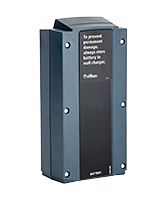 |
Necessary for a heavily used TRAM, allowing one battery to charge while the other one is in use. |
|
Additional thigh straps 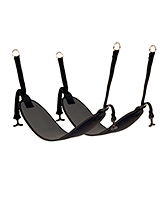 |
Needed to accommodate cleaning schedules of a heavily used TRAM allowing one set of leg straps to be cleaned while the other is in use. |
|
Switch Pole  |
The switch pole allows raising and lowering the TRAM by either the client or the caregiver. |
|
Removable back belt  |
Removable back belt provides a clip at both ends for easy removal and sanitation, required when infection control is critical. |
Don’t forget to include pictures of the Rifton TRAM.



